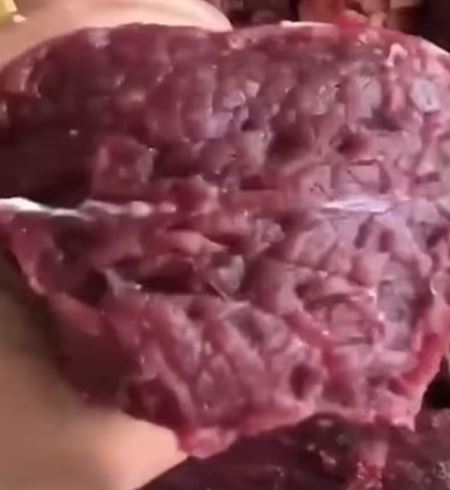
Released by the Twitter account "Weird and Terrifying," the video captures a piece of meat erupting into spasms.

The video went viral on Facebook in 2020, showing the consequences when butchers add salt to freshly cut meat.
This essential procedure serves not only to draw out the water from the surface but also to ensure its long-term preservation.
However, as highlighted by Reddit user Jackson from the US, this technique comes with a rather unpleasant side effect.
In the viral video, an unidentified butcher presents the meat to the camera, providing viewers with a closer angle of it as it spasms.

The meat's surface seems to almost bubble as it reacts to having recently been coated in salt.
According to experts, this phenomenon is exclusive to the freshest meat, and the pulsating motions are attributed to the nerve endings of the animal—which remain 'alive' in a manner—reacting to the introduction of salt.
As soon as the salt is drizzled onto the freshly cut meat — assuming it's beef, given its appearance — an effect is triggered in which the meat undergoes contractions and spasms, almost as if it were animated.

Interestingly, this phenomenon has found its way into culinary practices, adding an element of curiosity or disquiet — depending on one's perspective — to the dish.
Perhaps you've come across videos featuring freshly prepared squid dishes doused with soy sauce, causing the tentacles to wriggle as if they were still alive.
Likewise, there are instances where frog legs are subjected to a similar treatment using salt, showcasing a comparable reaction.

To begin, the meat used for this culinary intrigue must be exceptionally fresh.
Fresh to the extent that the neurons within the flesh remain undamaged and retain their capability to react—this forms the hidden essence of this phenomenon.
Whether in the form of granulated salt or salty soy sauce, the application of salt triggers a reaction from these neurons, thus initiating the observable responses in the meat.
On the other hand, an article published last year in Scientific American provided a complex explanation: “All cells are polarised, which means the concentrations of charged atoms, called ions, of the fluid inside them is different from the fluid outside them. “It is this difference in ion concentrations that creates a difference in charge (or voltage) across membrane."
“This difference - called a membrane potential - allows neurons to work.”
Watching the video below:




